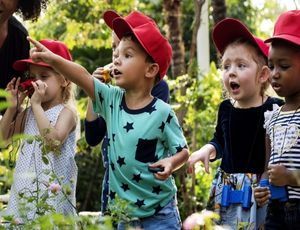From the moment your toddler started walking, he started practicing how to control his lower body, all muscles, and bones. His mind and body are now going through an intense period of connection, and many milestones can be acquired now, like running, jumping, and toileting independently. Yes, you read that right, your toddler now has the physical ability to leave the diapers behind and use underwear. Of course, he will need lots of practice and support. Keep reading, because this month’s article has very rich information about toileting awareness.
Learning to use the toilet represents a significant step towards functional independence for every child. Usually, families start thinking about it sometime before the child’s third birthday. However, children are ready to achieve this milestone long before; the more you wait, the more effort you and he will have to put into this process. So, let’s look at this bit by bit.
Physical Development
The sphincters are the two circular muscles responsible for holding or releasing urine and bowel movements. For newborns, the movement of the sphincters is involuntary. For older children and adults, this movement can be voluntary. Like every muscle in our body, they need practice before completely controlling them. So, as soon as a child starts walking, he could practice tightening and releasing his sphincters!
Signs that Your Child is Ready
- Pulling at his diaper when he is soiled or wet.
- Taking off his diaper.
- Squatting or going to an isolated place to have a bowel movement.
- He is communicating with you or any other caregiver that his diaper is solid or wet.
- Shows interest in being in the restroom while somebody is using it and observes closely.
- Enters the bathroom at different times of the day just to look around.
Signs that You are Ready to Support Your Child
- You understand that toileting is a process that needs time and practice, and it is not a decision that you make.
- You are comfortable using the appropriate vocabulary and support the routine of using the toilet independently.
- You have prepared the home environment for your child to use the toilet as he needs.
- You understand there is no specific time frame for your child to achieve it. Every child is different.
- You understand what observation means and are comfortable observing your child identify any patterns related to this process. For instance, times of the day when he usually has his bowel movements.
- You have talked with other primary caregivers of your child to foster consistency in this process.
Accurate Language
It is essential to use the correct language in all aspects of your child’s life. Toileting awareness is an excellent opportunity to teach your child the correct and consistent words for the parts of his body, their functions, and items used to care for his body.
- Toilet instead of potty.
- Bowel Movement instead of poop, poopy, poo-poo, etc.
- Urine instead of pee or pee-pee.
- Penis/Vagina instead any cute nicknames.
- Passing gas instead of fart.
- Strong smell instead of a stinky.
We want our children to be comfortable with their body, to understand that having eliminations and using the toilet is part of a healthy body, and they should not be ashamed of it or feel they are doing something “dirty.” Every part of their body deserves respect and acknowledgment of their functions. There is no need to use nicknames or diminishing terms for them.
Why toilet awareness and not potty training?
Words are very powerful. When we think about the word training, we think about rewards and demanding a result as soon as possible. When a pet gets trained to do tricks, treats are used to motivate the pet, and if there is no treat, there is no trick, making it evident that the pet does not want to do the trick, just the treat.
Once we understand there is an internal physical process that needs to happen for our child to use the toilet, we know that there is no benefit of using treats, because it is not training. It is a process the child needs to be aware of, which requires practice, time, and patience, not a reward system. He needs the opportunity to be aware of his body to connect the brain with the muscles responsible for eliminations.
How to prepare the home-environment
- Make sure the child has free access to the toilet during the entire day. Avoid using a crib to sleep in because he won’t be able to use the bathroom if he is trapped in there. Also, remove any door safety lock or latch from the bathroom door.
- Provide a small portable toilet or a toilet adapter for the child to sit comfortably balanced.
- Provide a wide stool that allows the child to rest his feet when sitting on the toilet adapter.
- Have toilet paper, soap, water, and towels available for him so he can practice the entire routine when needed.
- Have changes of clothes handy at your child’s height for him to change in case he wets or soils his clothes.
- Have a hamper for soiled clothes available for him.
Clothing for Independence
Provide options for clothing to your toddler that allow him to pull up and down easily. Avoid complicated straps, zippers, and buttons that will make it difficult for him to remove his clothing quickly. Also, avoid very tight or loose clothing.
How to prepare your toddler before starting
- Change his diapers as soon as he eliminates and avoid giving him the message that he should be comfortable when he feels his bottom wet or soiled.
- Use proper body language and talk about what happens when you change a diaper, so he starts to connect what he feels with what his body is doing.
- Once he starts standing up with balance, change his diapers standing up. This way, he will be able to observe what happens on his body when a diaper is being changed and will be able to cooperate with you to dress and undress.
- Let him observe you when you use the toilet. He needs to absorb the entire routine to understand how it works.
- Use cloth diapers if possible so he can feel his eliminations and starts to make a connection with his body. Remember, a disposable diaper will remove any kind of sensation.
- Avoid using pull-ups as a transition to underwear; they are the same as disposable diapers and they remove the sensation of the elimination. They do not foster the body-mind connection. Instead, work on pulling up and down with real clothes.
Give a Heads-Up to Your Toddler
Once you observe signs of readiness in your toddler, you are prepared, and the environment is ready, give him a heads up. Any change in the routine will be easier to take if he knows it in advance. Make it an exciting moment for him instead of transmitting that is going to be hard and take time. It does not have to be like that.
Book of the Month
Sarah Moudry – Toileting Awareness
This is a short, easy to read and full of knowledge book that every parent planning to support their child with the toileting process should read. The author is a Montessori Educator and Parent Coach.
Link to buy it at Amazon.com: https://www.amazon.com/Toilet-Awareness-Montessori-Philosophy-Learning/dp/0986143723/ref=sr_1_1?keywords=Toileting+Awareness+Sarah+Moudry&qid=1582677133&sr=8-1
Have a little extra time?
Toilet Learning - Montessoriguide.org
Enjoy this 12-minute video that will take you through the entire process of toileting learning in a Montessori environment. You will be able to observe multiple prepared environments and children enjoying their part of this process.
https://vimeo.com/121200116
Item of the Month
Toilet Adapter
Install this toilet adapter that allows your child to pull it down to use it and allows you to pull it up when it is not being used.
https://www.amazon.com/Summer-Infant-Toilet-Trainer-Oval/dp/B016Q0ZY3U/ref=sr_1_4?keywords=toilet+toddler+adapter&qid=1582686122&sr=8-4
Quote of the Month
“A child who is self-sufficient, who can tie his shoes, dress, or undress himself, reflects on his joy and sense of achievement the image of human dignity, which is derived from a sense of independence”
-Maria Montessori



